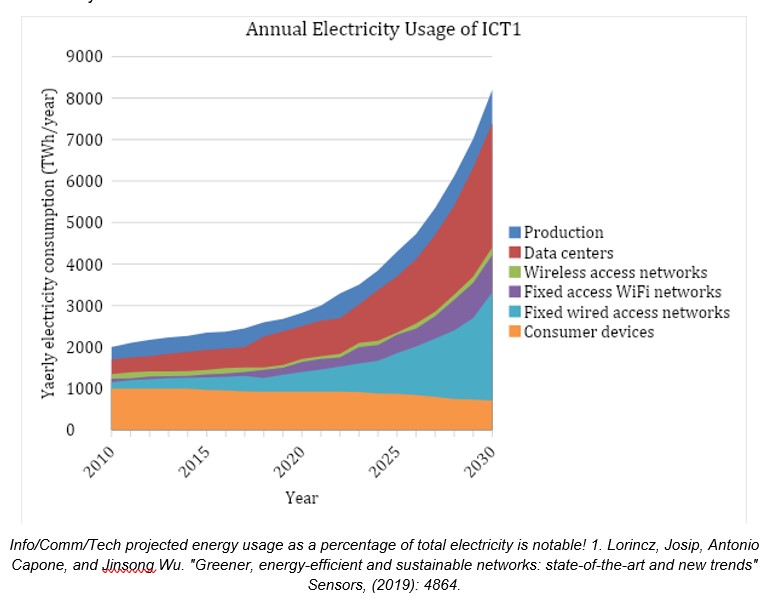In this century, few issues have dominated our collective consciousness as much as climate change and environmental sustainability. However, only recently has the communications industry recognized its responsibility to help solve this incredibly complex global issue. Energy use continues to strain multiple industries, driving up costs and imposing constraints on growth that can be avoided. For most major economies, there is a significant business incentive to see energy reductions across the board. The wireless industry is no different, with multiple groups, companies, and governments quickly realizing that it has its own role to play in building a more sustainable industry.
Like all industries, the wireless sector is definitely consuming significant energy resources. The information/communications/technology market has steadily consumed more and more electricity, with more growth in sight as we move from 5G to 6G and beyond. Adding billions of new devices to the network (via the IoT and other means) will significantly increase this burden. By some estimates, the communications industry is set to consume almost 20% of all energy resources by 2030.
This increased energy usage has not gone unrecognized within the wireless market. In this era, the telecommunications industry is awakening to its role in addressing climate change and sustainability concerns. As we transition from 5G to 6G and beyond, there's no denying that the industry is consuming significant energy resources. However, the potential for technology to drive efficiency and sustainability across multiple sectors is enormous.
Take 5G, for instance, which is already demonstrating its capacity to reduce energy needs and enhance productivity in various industries, including energy management in smart buildings and Industry 4.0 in the manufacturing sector. Beyond our own infrastructure, these advanced upcoming technologies are enablers for tremendous amounts of energy consumption savings and sustainability in almost every industry, transforming the telecommunications providers into agents of change as well. These are clear illustrations of how advanced technologies are poised to mitigate energy-related challenges.
Sustainability via New Technologies
More than most, our industry has advanced technologies at its disposal that have great potential to reduce our own environmental impact, as well as that of our customers. 5G is already being deployed in use cases worldwide that reduce energy needs and increase efficiency and productivity for multiple industries. Energy management in smart buildings is already a clear application, and results are seen in several markets. Singapore has deployed 5G for energy management across numerous smart buildings and is seeing excellent results (Energy and AI, January 2022).
The manufacturing industry is actively evaluating 5G to enable Industry 4.0 and the Industrial Internet of Things (IIoT). A recent study by ABB found that 94% of key decision-makers across 12 industrial segments agree that IIoT can improve overall energy efficiency. Moreover, 72% are looking to increase spending on this technology due to its impact on sustainability. Energy management, waste management, extending equipment life, and emissions monitoring and control are just a few of the environmental benefits that 5G helps to enable.
These IoT benefits also extend to the agriculture industry, as 5G-enabled IoT sensors can contribute to sustainable food production practices. Collectively known as precision agriculture, these wireless-enabled systems collect and analyze data on moisture, sunlight, air quality, and other factors that influence crop growth. Moreover, 5G wireless tools help reduce the use of pesticides and fertilizers by informing farmers to dispense them solely where necessary, not across entire fields.
As 5G continues to evolve with future releases (notably 5G NR Rel 18) more energy savings will be possible. This also includes new versions of Wi-Fi, with Wi-Fi 7 coming online this year, and new technologies such as network slicing, enabling more efficient use of existing spectrum and legacy networks.
When evaluating these new technologies, it is Important to emphasize that the success of these technologies isn't solely tied to their energy consumption but also to their potential for energy savings, even in the most traditional sectors like Agriculture.
One key factor to keep in mind is that assessing future energy consumption may not be a fair indicator. The energy demand is primarily driven by the increasing demand for advanced technologies. New technologies, however, come with a wealth of energy-efficient, self-optimizing features. Take, for example, the scenario of covering an outdoor parking lot; it could require hundreds of traditional Wi-Fi access points, but it could be more efficiently achieved with just a couple of small cells, demonstrating the inherent efficiency of newer technologies.
Embracing New Deployment Strategies
Beyond helping other industries reduce their environmental impact, the mobile ecosystem needs to take steps to mitigate the effects of our design and deployment practices related to sustainability. One enormous deployment decision that could significantly impact energy efficiency is the ongoing trend of over-provisioning in mobile networks. Both mobile operators and enterprises should ensure that they’re designing as efficiently as possible upfront. Moreover, these networks are dynamic environments that need to be periodically recalibrated. Over-provisioning simply makes this more challenging while simultaneously adding to energy costs.
Another obvious choice can be to prioritize using renewable energy sources for data centers, smaller cell deployments, and other installations requiring significant energy. Many companies are investing in renewable energy sources, such as solar and wind power, to run their operations. This shift helps reduce the carbon footprint associated with energy consumption.
Complementing this choice might be the development of more sophisticated battery-based energy storage to augment our renewable energy sources with an uninterruptable power supply.
The move away from over-provisioning in mobile networks is a significant step towards enhanced energy efficiency. Efficient design and resource allocation, coupled with renewable energy sources and battery-based energy storage, can further minimize energy consumption in the telecom sector.
Other emerging strategies include a continued shift to virtualized infrastructure. Much as larger mobile operators leverage software-defined networks and cloud native architectures, these trends set the foundation for additional energy-efficient technologies such as OpenRAN solutions, Neutral-Host Networks, and others.
Other potential strategies could include reducing RAN energy consumption, reducing our industry’s overall land use footprint, and creating a circular economy to reduce e-waste, something our industry generates in large quantities.
Energy Efficiency and Sustainability as Part of Wireless Network Design
Aside from the use cases that mobile technologies enable, the global ecosystem is taking steps across multiple standards groups – the very organizations that define wireless technologies for the industry – to make sustainable practices a critical element in the development of future mobile networks. Organizations like the 3GPP, Next G Alliance, Wireless Broadband Alliance, and many others are working to build sustainability into today’s mobile infrastructure.
Many other organizations are also building sustainable practices into their planning for 6G and other future network technologies. It’s clear that, as an industry, we are at least beginning to take the threat of overconsumption seriously. These goals will take time to achieve. It will require dedication, sacrifice, and broad cross-industry collaboration. But as a wise person once said, focus on what you can control. At the very least, we have the opportunity to create new approaches, helping to address the impacts of this complex trend.
Nazim Choudhury is the Director of Market Development at iBwave Solutions.
Related articles:










